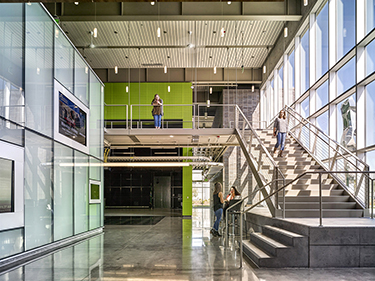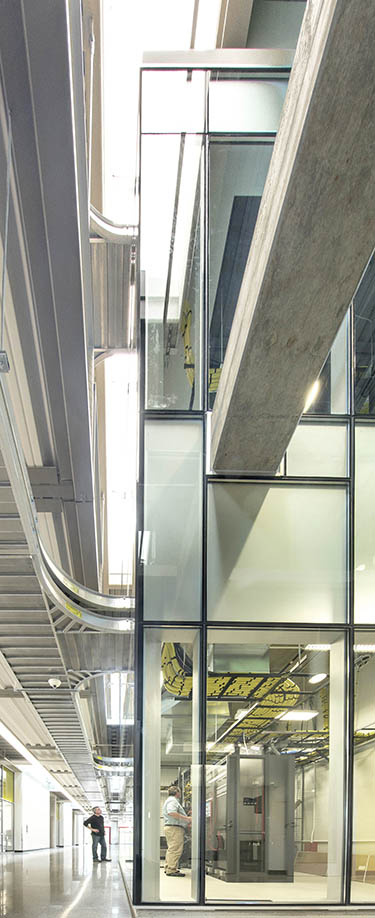|
Subscribe / Renew |
|
|
Contact Us |
|
| ► Subscribe to our Free Weekly Newsletter | |
| home | Welcome, sign in or click here to subscribe. | login |
Construction
| |
 |
November 21, 2019
Designing classrooms that meet the needs of tomorrow’s jobs
McGranahan Architects

Myles
|

Stevens
|
The workplace is changing. The rapid pace of progress in technologically driven careers, known as the fourth industrial revolution, requires today’s college and university students to prepare for jobs that don’t even exist yet.
The skill set required to deploy oneself in the professional unknown means that schools must find a balance between teaching practical skills and imparting adaptable knowledge.
STEAM (science, technology, engineering, art and math) pedagogies draw from either end of this educational spectrum to bring together the conceptual critical aspects of abstract thinking and solidify them with concrete examples and real-world applications.
When designing a STEAM learning environment, an architect should also pull from diverse architectural settings, to be able to weave the opaque + fixed with the transformable + agile to break down traditional environmental barriers and reveal the collaborative power of both working and learning. Ultimately, the best workplaces capture the essence of a learning environment, and the best schools capture the essence of work in return.
The classroom is changing to meet the needs of this new work environment. In fact, the term classroom is so foreign to the needs of today’s college students we seek to escape using it. We default to relabeling the classroom with fashionable terms, some of which fail to ask what it is about the newly termed setting that is vital to the activity within. Can the label alone ever meet the needs of students that are expected to use knowledge from one aspect of academia to solve problems in another in real time?
Overlap in skills and knowledge is becoming a focus for educators. This balance between the practical and the theoretical is exactly the foundation for what makes a STEAM pedagogy the driving force in the educational revolution.
It has led a wave of emerging pedagogies and project-based curriculums founded on uncovering the natural ways the often-separated buckets of knowledge build off one another. The one common thread amongst all the different teaching theories is the oscillation between abstract thought and real-world application.
A playground and retreat
As education changes, the learning environment must also change to afford students space and place that supports a process of putting ideas on display to test and discover meaning. How do architects adapt to these changes? How do we design a higher education environment that provides both a practical playground and a theoretical retreat?
As the pedagogy changes, it breaks self-fulfilling cycles and feedback loops. Architects must ask where we can reinforce the breakdown of silos and build overlapping transparencies into a learning environment. How can we set the table for interaction and exchange (the foundation of collaboration) and allow the appropriate learning setting to emerge?
The application of fashionable terminology alone falls short of uncovering the potential held within the new name. Any list of alternative names implies there is something about a “classroom” that fails to mirror the advancements in the educational models they support. They reveal there are edges we must fold down to allow interchange and ideological commerce to happen.
In other words, we must ask ourselves why we need alternative labels to give ourselves license to innovate when the elements are fundamental and already familiar:
The opaque: Quiet, inward-focused, moments of pause, a place to sit and look, the place for the single — the ordered, rigid and fixed elements, service and core. The stacks, the stairs, the lines of progression.
The transparent: Agile space — a studio — a place to experiment on desks, computers, paper and media. A place to make. These properties we give to the practical spaces — the hands-on spaces, spaces for demonstration, to be on view and to view.
STEAM case study
The Bates Technical College Advanced Technology Center is a case study for how designed spaces allow for education and workplace to merge. It is built on the core principles of STEAM.
Nestled in Tacoma’s diverse Hilltop neighborhood, Bates shares a site with a working public broadcasting station. The school at large and the building itself provide a seamless transition from a learning environment to a working studio.
The broadcasting station offers students hands-on opportunities to hone their skills on productions and actively blend the working and learning environment into one. The boundary between when you are learning and when you are practicing a profession is a perforated line that asks for a fluid transition from one to the next.
Interstitial spaces offer opportunistic study settings and chance encounters with fellow students designed to spur collaboration. One moment students may be watching a live broadcast from the catwalk suspended just outside the green screen room, and the next may have a conversation about the intricacies of capturing that moment on film.
These exchanges are possible by strategically organizing adjacent learning and working spaces to instigate thoughtful interchange. The corridor is no longer a simple process of moving through; rather, it provides opportunities to pause, reflect, share or collaborate. Scales of interactions offered up by the diversity an inward reflective moment and outward projective connections.
At the core of the Advanced Technology Center is a working glass-box server room — the literal inner-workings of the school on display as they weave throughout the building. This setting is a glimpse into the profession a student may be preparing themselves for.
By swapping out the typical server closet for a transparent wall, the server goes beyond servicing the building, quietly humming away in a forgotten corner. By revealing this as a test environment of overlapping function, the server room breaks out of the box and becomes an integral part of the hybrid learning/working space.
There are several questions we must continue to ask ourselves when designing a STEAM learning environment to be able to successfully weave the opaque + fixed with the transformable + agile: What it is about the current classroom that is not providing for the needs of the current student in rapidly advancing disciplines? Who is best served by the design process? Who needs to be at the table to raise the right questions and offer the right opportunities?
How do we design spaces that are rigid enough to support academic pursuits balanced by innovation spaces geared towards practical learning? What barriers can we break down so these spaces don’t become silos of learning? How do we leverage adjacencies and overlaps to inspire collaboration? What kind of space enables current college students to hone their collaboration skills, immerse themselves in their work and broaden their field to fuel exponential growth?
Rory Stevens is a project designer and Glenn Myles is a senior project designer, both with McGranahan Architects.
Other Stories:
- 3 projects that show how unique context can inspire unique design
- Make your transition to a new building a smooth one
- 3 STEM projects that aim to break down learning silos
- How higher ed projects can benefit from P3 delivery
- Why it’s a good idea to use mechanical design-build for your school project
- New lab building anchors UC San Diego research park
- How maker labs can open doors to STEM careers
- UW building takes fast track with integrated design-build
- Community college complex will be a hub for agriculture
- Creating a sense of place for students in rural Washington




